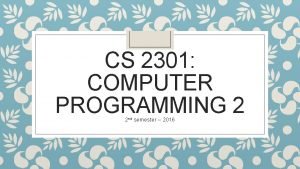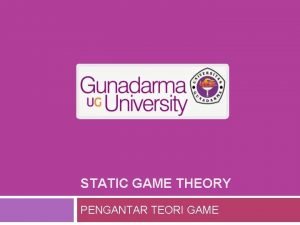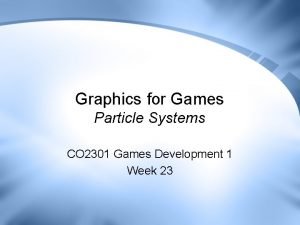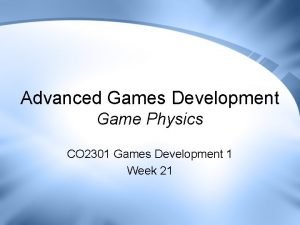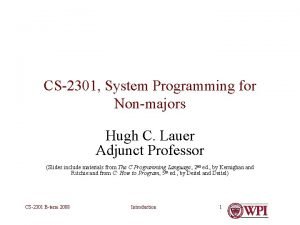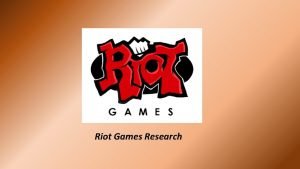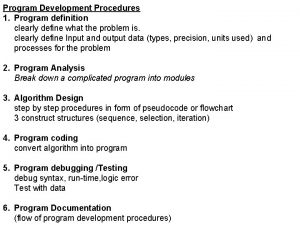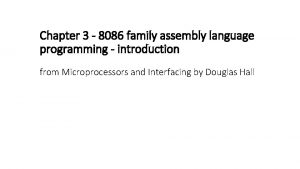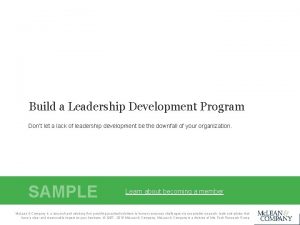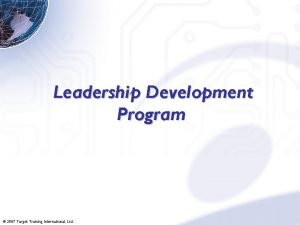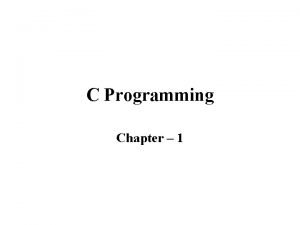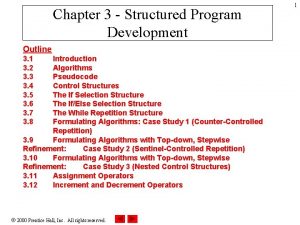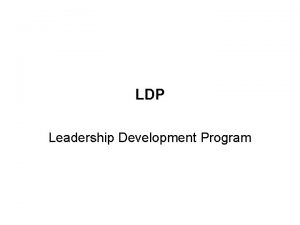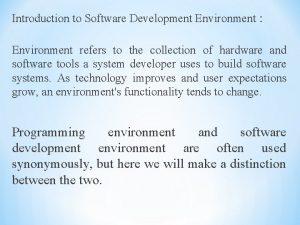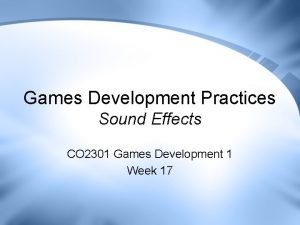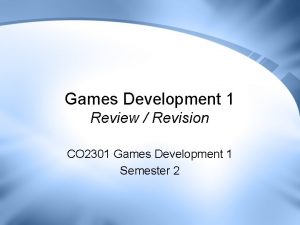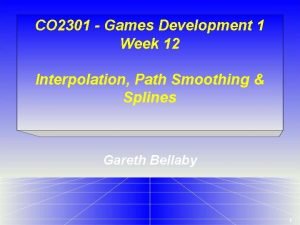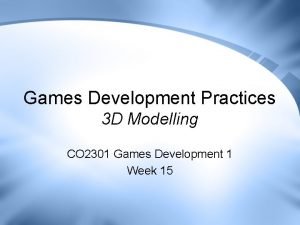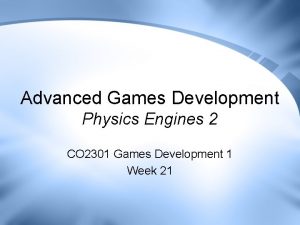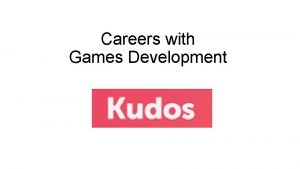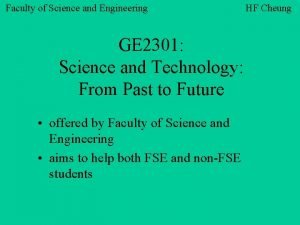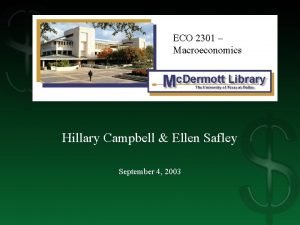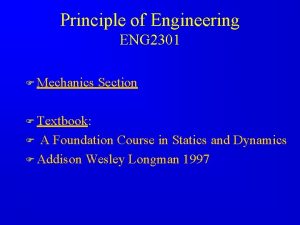Games Development Games Program Structure CO 2301 Games




























- Slides: 28

Games Development Games Program Structure CO 2301 Games Development 1 Week 19 -20

Today’s Lecture 1. Cross-Platform Programming 2. Using Interfaces • Code Reuse & Efficiency 3. 3 D Engine Architecture • Manager Classes 4. Game Architecture • • DAGs Globals / “Tramp” Data / Singletons

Cross-Platform Programming • When possible, the technology behind a game should be independent of: – – Platform (PC, Playstation, Xbox etc. ) API (Direct. X, Open. GL, console specifics, etc. ) Middleware (Sound API, physics engine etc. ) Game – i. e. should be reusable for other games • This should apply to all game aspects: – 3 D rendering, AI, physics, scripting etc. • How do we engineer such portable code?

Cross-Platform Programming • Key step is to separate commonly used code from platform/game specific code – E. g. Managing a list of models (creation, movement, deletion) is similar on all platforms – Whereas actually rendering the models is platform / API specific • We use interface classes and abstract classes to efficiently handle this situation – Incomplete classes containing common code – Further implementation classes provide platform specifics • We need to consider this separation from the beginning – This is software architecture

Introducing Interfaces • An interface class (using C++ terms) has: – No member variables – Only pure virtual functions: prototypes with no code • Only defines functions - does not implement them – We cannot create objects of this class • An abstract class is partially implemented: – May have member variables and implementation – But still has some pure virtual functions • Interface / abstract classes must be inherited by one or more implementation classes – Which must implement all the missing functions

Interfaces in the TL-Engine • Interface/abstract classes define required features and provide some common code • Implementation classes provide the functionality for different platforms – This is called a framework • The TL-Engine uses interfaces exclusively: – I 3 DEngine, IMesh, IModel, ICamera etc. • Each of these classes defines a set of functions but does not implement any of them – Start. Windowed, Load. Mesh, Rotate. X, etc.

Interfaces in the TL-Engine • Only the source code for the interface classes is available to TL-Engine apps through the “TL-Engine. h” header file – This is all the specific TL-App needs to know • Inherited implementation classes are found in the TLEngine library files – Multiple versions are provided: • TLXEngine, TLXMesh; Irrlicht. Engine, Irrlicht. Mesh etc. – Could add more (e. g. GLEngine, GLMesh) • Libraries are brought in during the compiler’s linking phase – Source code is not made generally available

Interface Example class I 3 DEngine // Interface class (as seen by app) { public: virtual void Create() = 0; } // Implementation class (in the library, source code not shared) class TLXEngine : public I 3 DEngine { public: void Create() { m_p. D 3 D = Direct 3 DCreate 9( D 3 D_SDK_VERSION ); } private: LPDIRECT 3 D 9 m_p. D 3 D; }

Interfaces in the TL-Engine • The ‘New 3 DEngine’ function is the only procedural function available in the TL-Engine • This is a factory function that creates an 3 D engine of a given type (e. g. TLX) – It returns an implementation class object – TLXEngine or Irrlicht. Engine in current version • All subsequent objects are created using this class and will be returned as matching classes: – TLXMesh, TLXModel, etc. • The user’s TL-App is entirely platform / API independent – Gets platform support from specific TL-Engine libraries

Interface Example Cont… // Factory function – creates objects of a given type I 3 DEngine* New 3 DEngine( Engine. Type engine ) { if (engine == k. TLX) { return new TLXEngine(); } else //. . . create other supported types } // Main app, ask for I 3 DEngine pointer of given type I 3 DEngine* my. Engine= New 3 DEngine( k. TLX ); // Use pointer (underlying object is TLXEngine type) my. Engine->Start. Windowed();

TL-Engine Class Diagram

Another Interface class IModel { // Interface class (as seen by app) public: virtual void Render() = 0; // No code in interface } // Implementation class (a version for Direct. X) class CModel. DX : public IModel { public: void Render() { //. . . Platform specific code in implementation class g_pd 3 d. Device->Set. Transform(D 3 DTS_WORLD, &m_Matrix); //. . . } private: D 3 DXMATRIXA 16 m_Matrix; }

Another Factory Function // Factory function – creates objects to suit engine IModel* CEngine: : Create. Model() { if (m_Engine == Direct. X) { // Engine type is known return new CModel. DX; // Return matching model } else //. . . create other supported types } // Main app: ask for IModel ptr, gets type based on engine IModel* my. Model = my. Engine->Create. Model(); // Use pointer (underlying object is CModel. DX type) my. Model->Render();

Abstract Classes: Code Reuse • TL-Engine uses interfaces, not abstract classes – All functions must be re-implemented for a new platform • There is often common code that can be identified for a game component – Better to use partially implemented abstract classes • The underlying TLX engine takes advantage of this: – Many classes are entirely platform independent – Other classes have common code provided in an intermediate abstract class: ITexture. Surface (interface class) -> CTexture. Surface (abstract class - common code) -> CTexture. Surface. DX (implementation class - Direct. X specifics)

TL-Xtreme: Texture Classes

Framework Issues • Use of virtual functions is called polymorphism • An important OO technique, but not perfectly efficient – Make sure interface user does not need to make very frequent polymorphic calls (e. g. thousands per frame) – Also ensure underlying implementation avoids too many polymorphic calls – However, don’t naively overestimate this problem. A more flexible architecture is much better than an 0. 05% speed-up • Also watch out for writing over-general common code – Too much code reuse can lead to less efficient approaches – So write general code usable by all implementation classes – Then allow them to override with efficient specialised versions

3 D-Engine Architecture • A 3 D Engine / API is usually controlled by a central engine / device interface class – Providing control over core features: • Start-up, shut-down, device switching • Output control (window / fullscreen / multi-monitor) • Global rendering state • The TL-Engine provides the “I 3 DEngine” interface • In the TL-Engine this interface also handles resource handling and a host of other features – E. g. Load. Mesh, Load. Font, Create. Camera, Key. Hit… • This leads to a very bloated core class

Manager / System Classes • It is better to distribute related tasks to secondary manager or system classes • The core interface then provides access to these secondary class interfaces: – Resource managers: textures, buffers, materials etc. – Scene managers: scene nodes, spatial structures – Also system utilities: Input, logging / console etc. • Each manager class is responsible for a certain kind of resource / scene element: – Creation, deletion, loading and saving – Related system and hardware settings

3 D Engine Architecture 2 • Engine user must use manager classes to create and delete resources – cannot create anything without them – Managers are responsible for final clean-up of their resources – Memory leaks can be made less likely (consider how TL cleans up) • They may also be used to select / use particular resources – E. g. Set. Texture – to use a particular texture • The actual resources themselves (e. g. textures) often present a very limited interface – Perhaps only getters/setters – Limited (if any) system / hardware control • Although the implementation classes are likely to be rather more complex

TL-Xtreme: Core 3 D Classes

Overall Class Architecture 1 • Note that there are no cyclical dependencies – I. e. No classes that mutually depend on each other – As illustrated by the aggregations/dependencies • We can use this as a design paradigm – Implying that lower level classes are ignorant of higher level ones – This strongly promotes loose coupling • This is equivalent to saying that the class structure forms a Directed Acyclic Graph (DAG) – Tends to be a tree-like graph – So we can identify separate sub-graphs that are also loosely coupled

TL-Xtreme as a DAG

Overall Class Architecture 2 • Note also that this approach shows clear lines of ownership / responsibility (compositions) – Follow the composition arrows from the core class outwards • We should also make sure we are clear on these lines of responsibility • In general, every object should be either a core object or the responsibility of just one other object • This often leads to a tree structure for the compositions in our UML diagrams – Not always though - use extra care for these more complex cases

Side Note: Global Data • The use of global data is generally bad practice, especially in larger projects – Difficult to be certain of value / state of a global when accessible anywhere, by anyone – Especially a problem if different team members use it • But it is common for a few key pieces of data to be required in many parts of a larger system – E. g. the Direct 3 D device pointer, Device, which is used for almost all D 3 D calls • How to avoid the use of globals for such data?

Managing Widely Used Data Three (and a half) solutions: 1. Use globals anyway in these rare cases – May be OK in a simple case (purists would complain) – Is likely to harm flexibility, and cause problems in a team situation 2. Pass the data around as parameters – This can be onerous and repetitive, passing the data from class to class, function to function – Can find data passed many levels deep (tramp data), harms efficiency surely? – Maybe not – if only one parameter.

Managing Widely Used Data 3. Use a singleton object to hold the data – A class that can only have one object ever created of it • Use a special technique to set this up – We make the object widely visible. – Allows some encapsulation on the contained data – But still effectively a global – can suffer the same problems 3. 5 Pass global data to manager classes, but no further: – E. g. send D 3 D device pointer to any manager that needs it • E. g. CRender. Manager. DX to manage D 3 D rendering, Set. Render. State, Draw. Primitive etc. – Objects underneath the manager class must request the manager to do any jobs that require the global, or request the global directly • Awkward when an object needs a global but doesn’t directly have it

Globals through Manager Classes: • You might want an CTexture class to be able to: – Create / destroy hardware texture resources – Change hardware texture filtering, etc. • But storing D 3 D device pointer globally or per-texture might be a bad idea – The texture class can alter non-texture device state – Many hundreds of textures using same device pointer – Current device state hard to track • Instead CTexture. Manager does these tasks: – It stores D 3 D device ptr - interfaces with hardware – Textures must call manager functions to use Direct. X • Improves device encapsulation • Allows for more platform-independence

Disadvantages • In this example, a texture needs to call the texture manager for every hardware requirement – Potential performance issue • Also this introduces some coupling between the texture class and the texture manager – Textures rely on the functions of the texture manager – Although this can be seen as an advantage: • Texture manager class takes responsibility for texture lifetime • Maintains consistent device state relevant to textures • Each texture still needs a pointer to the texture manager – Is that better than a pointer to the D 3 D device? – Few right-or-wrong rules in engine architecture, only choices
 Dcm-2301
Dcm-2301 Znid-gpon-2301-eu
Znid-gpon-2301-eu Cs 2301
Cs 2301 Game 2301 belajar
Game 2301 belajar Game 2301
Game 2301 Game 2301
Game 2301 Cs 2301
Cs 2301 Describe katniss’s quarters.
Describe katniss’s quarters. Outdoor games and indoor games
Outdoor games and indoor games Tom cadwell
Tom cadwell Historical background of community development in tanzania
Historical background of community development in tanzania Development that ended much development crossword
Development that ended much development crossword Pattern of development
Pattern of development Program development definition
Program development definition Rockefeller professional development
Rockefeller professional development Ej gallo sales leadership development program
Ej gallo sales leadership development program Assembly language program development tools
Assembly language program development tools Leadership development program framework
Leadership development program framework Target leadership development program
Target leadership development program Fulbright faculty development program
Fulbright faculty development program Artisan development program
Artisan development program Program development steps in c
Program development steps in c Npbbdd
Npbbdd Program development outline
Program development outline Rdi relationship development intervention program
Rdi relationship development intervention program Leadership development program
Leadership development program Institutional development program
Institutional development program Community development program
Community development program Program development environment
Program development environment


